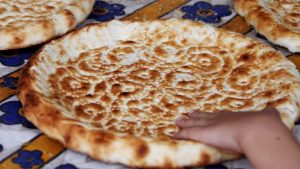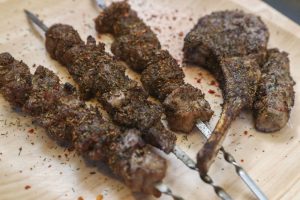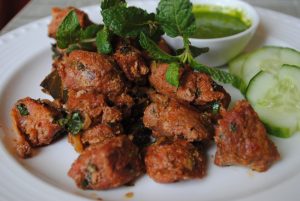
 I thought I was going for a Chinese food festival. Instead, what I got was Kashmiri food. It was all rather disorienting till I made the Silk Route connection.
I thought I was going for a Chinese food festival. Instead, what I got was Kashmiri food. It was all rather disorienting till I made the Silk Route connection.
Chef Li Peng, the hugely talented Chinese chef of Vasant Continental in New Delhi had put together a food festival of the Xinjiang region of China. There was no way I was going to miss it – I’m a huge fan of this young chef, whose food and personality both vie for attention.
Peng gave me a crash course in the food of the Uighurs before he brought me the menu. Apparently, while the eastern  half of China is heavily populated, the western half is a vast desert and is sparsely populated. Quite a lot of the people are not Han Chinese at all, but another race entirely, most of whom belong to the Muslim faith. Their food habits are dramatically different from their Han neighbours, while having a few commonalities into the bargain. Uighurs are one community in this melting pot: all Uighurs are Muslim, but not all Muslims are Uighurs in Xinjiang, the largest province in West China.
half of China is heavily populated, the western half is a vast desert and is sparsely populated. Quite a lot of the people are not Han Chinese at all, but another race entirely, most of whom belong to the Muslim faith. Their food habits are dramatically different from their Han neighbours, while having a few commonalities into the bargain. Uighurs are one community in this melting pot: all Uighurs are Muslim, but not all Muslims are Uighurs in Xinjiang, the largest province in West China.
The first course was what Kashmiris would call tujj, which essentially means stick generally and seekh specifically. Cubes of lamb or chicken are rubbed with a marinade of salt, chili powder, zeera powder (and crushed sesame seeds in the case of  Xinjiang), and grilled over coals. You could argue that boti kebabs are hardly a novelty all over India. The only difference is the size of the botis and the fact that neither Kashmir nor Xinjiang favour curd marinations. The taste of Chef Peng’s offering was surprisingly Kashmiri. Even more surprising was Peng’s assertion that streetside stalls in China that offer Xinjiang kebabs remove the piping hot kebabs from the seekh by wrapping bread around them. That’s exactly what they do in the seedy area of Srinagar’s Khayyam Chowk, where my husband and I go for plates of tujj.
Xinjiang), and grilled over coals. You could argue that boti kebabs are hardly a novelty all over India. The only difference is the size of the botis and the fact that neither Kashmir nor Xinjiang favour curd marinations. The taste of Chef Peng’s offering was surprisingly Kashmiri. Even more surprising was Peng’s assertion that streetside stalls in China that offer Xinjiang kebabs remove the piping hot kebabs from the seekh by wrapping bread around them. That’s exactly what they do in the seedy area of Srinagar’s Khayyam Chowk, where my husband and I go for plates of tujj.
However, it was at the sight of the bread itself that I was dumbfounded. It was the Kashmiri standby – tchot, eaten each and every single morning as a breakfast bread with tea all over the Valley. The only difference was that Chef Peng had it made in a five star hotel, so the central part had fork marks on it, whereas in Kashmir, a pattern would be created by fingernails.
The other surprise was the sliced lamb that was served with the same bread, this time, chopped into bite-sized pieces and stir-fried along with the meat. So overcome was I that I took some home to show my husband. “Naan ghosht!” he exclaimed in delight after he tasted the first morsel. “Where did you get it from?”
I’ve always wanted to visit Xinjiang because it represents one half of an image we all have of Kashmiri culture. Will I find Kashmiri cups there as a friend recently found in Uzbekistan? Will I discover some resonance of the Valley? I can hardly wait to find the answer.

